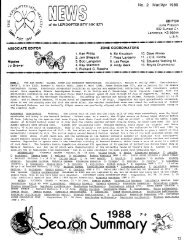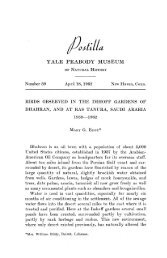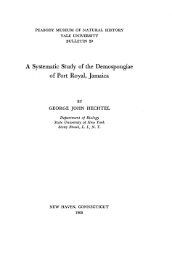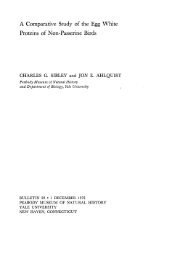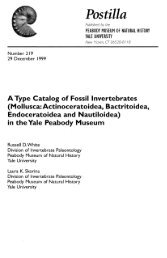Bulletin 3 - Peabody Museum of Natural History - Yale University
Bulletin 3 - Peabody Museum of Natural History - Yale University
Bulletin 3 - Peabody Museum of Natural History - Yale University
You also want an ePaper? Increase the reach of your titles
YUMPU automatically turns print PDFs into web optimized ePapers that Google loves.
10 PEABODY MUSEUM OF NATURAL HISTORYLophodytescucullatusHybrid No. 4745Bucephala clangulaamericanaLower mandible hasalong its upper edgescorresponding serrationswhich slant inward andbackward. The anteriormost<strong>of</strong> these unite t<strong>of</strong>orm a continuous knifelikeedge. (Fig. 7.) Noseries <strong>of</strong> ridges extendingon outer aspect <strong>of</strong>lower mandible.Both upper and lowerteeth remain visible whendried bill is closed.Tarsus,29-31 mm.Middle toe andnail, 52Number <strong>of</strong> scaleson top <strong>of</strong> outertoe, 44-46Scales in the row alongfront <strong>of</strong> tarsus (overlying3rd metatarsal) allsimilar; central ones notdistinctly wider thanthose below. (Fig. 13.)Has distinct crest, laterallycompressed; longestnape feathers, 48 mm.Lower mandible has oneach upper edge 40 smallserrations, or lamellae, <strong>of</strong>which the anterior extendbackward and inw&rd, andthe posterior directly inward.Anterior teeth notunited as in L. cucullatus.A series <strong>of</strong> 46 short externallamellae along thesuperior-lateral face <strong>of</strong>the lower mandible, eachtooth extending obliquelydownward and backward,as in Bucephala. (Figs.8, 11.)Closure <strong>of</strong> bill hides allthese teeth and lamellae.316144-47Scalation <strong>of</strong> left legas in L. cucullatus; <strong>of</strong>right leg as in Bucephala.(Figs. 14, 15.)Crest fairly developed;longest nape feathers,33 mm.On each upper edge <strong>of</strong>lower mandible is a series<strong>of</strong> 51 serrations or lamellae,<strong>of</strong> which the posteriorextend directly inwardand the anteriorobliquely backward andinward.A series <strong>of</strong> 46 welldeveloped lamellae alongeach side <strong>of</strong> bill as inmost ducks; each ridgeextends obliquely downwardand backward.(Figs. 9, 12.)Closure <strong>of</strong> bill hides allthese ridges.38-416854-56Middle scales in therow on front <strong>of</strong> tarsusdistinctly wider than theones below, thus reducingabruptly the width <strong>of</strong>the outer row <strong>of</strong> scales(overlying 3rd metatarsal).(Fig. 16.)No distinct crest; longestnape feathers, 23 mm.Head, entire neck,black. Broad white patchextends from back <strong>of</strong> eyeCOLOR OF MALEEntire head (includingcrest) and neck black,not extending so far pos-Head and upper neckblack, with strong greeniridescence; large round-



